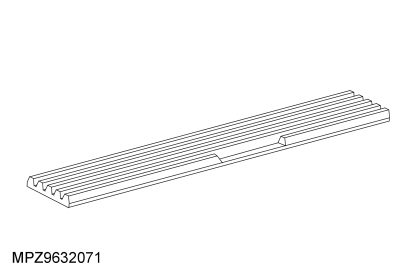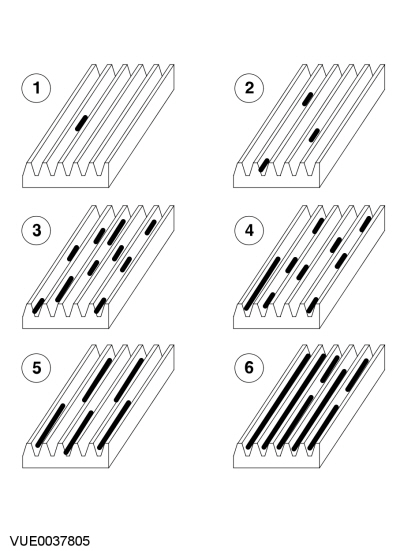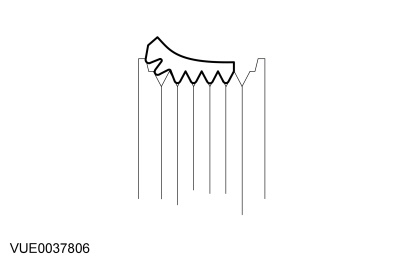Lincoln Navigator: Accessory Drive - 3.5L EcoBoost (272kW/370PS) / Accessory Drive. Diagnosis and Testing
Inspection and Verification
-
Verify the customer concern.
-
Visually inspect for obvious signs of mechanical damage.
Visual Inspection Chart
| Mechanical |
|---|
|
-
If an obvious cause for an observed or reported concern is
found, correct the cause (if possible) before proceeding to the next
step.
Accessory Drive Belt Concerns
NOTICE: Do not lubricate the accessory drive belt as potential damage to the accessory drive belt material construction may occur.
Cracking
Accessory drive belts are made from rubber which hardens with time and can develop cracks. As the accessory drive belt runs on the back of some of the pulleys, the cracks are opened up. Small cracks are not considered to be a failure of the accessory drive belt. Only if the crack is deep enough to reach the bottom of the groove to expose the cord or any chunks are found to be missing from the accessory drive belt, is the accessory drive belt condition considered to be unacceptable.
-
Check the accessory drive belt for cracks. If the damage
exceeds the acceptable limit, install a new accessory drive belt.
REFER to: Accessory Drive Belt (303-05 Accessory Drive - 3.5L EcoBoost (272kW/370PS)) .
Chunking
Chunking describes the condition where long lengths of rubber become detached from the ribs of the accessory drive belt. This is considered to be a failure of the accessory drive belt.

-
Check the accessory drive belt for damage. If any chunks are
found to be missing, install a new accessory drive belt.
REFER to: Accessory Drive Belt (303-05 Accessory Drive - 3.5L EcoBoost (272kW/370PS)) .
Pilling
Pilling is dust that forms in between the ribs of the accessory drive belt from rubber that is worn off the accessory drive belt when it is new. There may also be loose particles left on the accessory drive belt during the manufacturing process. These are worn off and form into small balls of rubber that then get trapped in the grooves of the accessory drive belt. This condition will usually clear itself within 4800 km - 8000 km (3000 miles - 5000 miles) of normal driving.

-
Check the accessory drive belt for pilling. The condition of
the accessory drive belt should be compared against the illustration.
-
Small scattered pills. Not considered a concern. No action required.
-
Small scattered pills. Not considered a concern. No action required.
-
Longer pills up to 50% of the rib height. Possible noise
concern. INSTALL a new accessory drive belt if noise is apparent.
REFER to: Accessory Drive Belt (303-05 Accessory Drive - 3.5L EcoBoost (272kW/370PS)) .
-
Longer pills up to 50% of the rib height. Possible noise
concern. INSTALL a new accessory drive belt if noise is apparent.
REFER to: Accessory Drive Belt (303-05 Accessory Drive - 3.5L EcoBoost (272kW/370PS)) .
-
Heavy deposits in the grooves. Possible noise and stability concern. INSTALL a new accessory drive belt.
REFER to: Accessory Drive Belt (303-05 Accessory Drive - 3.5L EcoBoost (272kW/370PS)) .
-
Heavy deposits in the grooves. Possible noise and stability concern. INSTALL a new accessory drive belt.
REFER to: Accessory Drive Belt (303-05 Accessory Drive - 3.5L EcoBoost (272kW/370PS)) .
-
Small scattered pills. Not considered a concern. No action required.
Incorrect fitment
Accessory drive belt noise can be generated by the accessory drive belt being incorrectly fitted on the pulley as shown in the following illustration. Make sure that all the V grooves on the accessory drive belt contact correctly with the pulley.

-
If the cause is not visually evident, verify the symptom and refer to the Symptom Chart.
Symptom Chart
| Symptom | Possible Sources | Action |
|---|---|---|
|
|
|
|
|
|
|
|
|
|
|
|
|
|
|
|
|
|
Component Tests
Accessory Drive Belt Tensioner - Static Check
The accessory drive belt tensioner may be checked statically as follows:
-
Inspect the area surrounding the accessory drive belt
tensioner for lubricant or other contamination. Rectify any leaks before
installing a new accessory drive belt tensioner. If the accessory drive
belt tensioner is contaminated, do not attempt to clean it as the
damping mechanism inside may be damaged. INSTALL a new accessory drive
belt tensioner as necessary.
REFER to: Accessory Drive Belt Tensioner (303-05 Accessory Drive - 3.5L EcoBoost (272kW/370PS), Removal and Installation).
-
Detach the accessory drive belt in the area of the accessory drive belt tensioner.
-
NOTE: The accessory drive belt tensioner has a damping feature, which is usually a friction device, therefore some friction within the system is normal.
Using the correct tool, move the accessory drive belt tensioner from its relaxed position through its full stroke and back to the relaxed position to make sure there is no excessive stick, grab or bind, and to make sure there is tension on the accessory drive belt tensioner spring.
-
Rotate the accessory drive belt tensioner pulley and
check for damage, freedom of rotation and alignment. INSTALL a new
accessory drive belt tensioner as necessary.
REFER to: Accessory Drive Belt Tensioner (303-05 Accessory Drive - 3.5L EcoBoost (272kW/370PS), Removal and Installation).
-
If the accessory drive belt tensioner meets the above
criteria, proceed to test the accessory drive belt tensioner
dynamically. If the accessory drive belt tensioner does not meet the
above criteria, INSTALL a new accessory drive belt tensioner.
REFER to: Accessory Drive Belt Tensioner (303-05 Accessory Drive - 3.5L EcoBoost (272kW/370PS), Removal and Installation).
Accessory Drive Belt Tensioner - Dynamic Check
The accessory drive belt tensioner may be checked dynamically as follows:
-
With the engine running, observe the accessory drive
belt tensioner movement. The accessory drive belt tensioner should move
(respond) when the engine is accelerated rapidly or when the A/C clutch
cycles ON and OFF (the degree of movement can be up to 4 mm). If the
accessory drive belt tensioner movement is not constant without engine
acceleration or A/C clutch cycling, a pulley or shaft is possibly bent,
out of round, or the damping mechanism inside the accessory drive belt
tensioner may be damaged. INSTALL a new accessory drive belt tensioner
as necessary.
REFER to: Accessory Drive Belt Tensioner (303-05 Accessory Drive - 3.5L EcoBoost (272kW/370PS), Removal and Installation).
-
Excessive accessory drive belt rideout (uneven depth of
grooves in the accessory drive belt) may cause excessive accessory drive
belt tensioner movement. Check the condition by installing a new
accessory drive belt.
REFER to: Accessory Drive Belt (303-05 Accessory Drive - 3.5L EcoBoost (272kW/370PS)) .
 Accessory Drive Belt Tensioner. Removal and Installation
Accessory Drive Belt Tensioner. Removal and Installation
Removal
NOTE:
Removal steps in this procedure may contain installation details.
Remove the accessory drive belt.
Refer to: Accessory Drive Belt (303-05C)
...
Other information:
Lincoln Navigator 2018-2025 Workshop Manual: Identification Codes. Description and Operation
VIN VIN Locator The VIN is a 17-digit combination of letters and numbers. The VIN is stamped on a metal tab riveted to the instrument panel, top upper left of the dash. The VIN is also found on the VC label. If the VIN plate requires replacement, authorized dealers must contact their respective regional office...
Lincoln Navigator 2018-2025 Workshop Manual: Brake Disc Shield. Removal and Installation
Removal NOTE: Removal steps in this procedure may contain installation details. Remove the brake disc. Refer to: Brake Disc (206-04 Rear Disc Brake, Removal and Installation). Remove the 3 bolts and the brake disc shield...
Categories
- Manuals Home
- 4th Gen Lincoln Navigator Service Manual (2018 - 2025)
- SYNC Module [APIM]. Removal and Installation
- Transmission Fluid Level Check. General Procedures
- Brake Service Mode Activation and Deactivation. General Procedures
- All Terrain Control Module (ATCM). Removal and Installation
- Front Bumper. Removal and Installation
Rear Drive Halfshafts. Diagnosis and Testing
Preliminary Inspection
Visually inspect the CV joints, housing, boots, and clamps for obvious signs of mechanical damage.If an obvious cause for an observed or reported concern is found, correct the cause (if possible) before proceeding to the next step
If the cause is not visually evident, verify the symptom and REFER to Symptom Chart: NVH.

